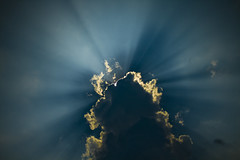I’d Like to Talk to You About The Earth

Ussher might have been on the wrong track but his hard work wasn’t for nought: he’s given us the perfect time to celebrate the awe-inspiring universe and the awesome Earth upon which we live:
6pm October 22nd: International Time for Awe.
Scientists know humility, curiosity, and awe. Humility is the only appropriate response to the scale and detail of the universe, and the almost-complete ignorance we have of it. Curiosity drives us to chip away at that ignorance by building verifiable and testable stories about the world. And, when we glimpse a truth or observe the world’s infinite majesties, we experience awe.

Science had its own quest to discover the age of the Earth. Geology drove it: rock comes in layers, there’s a rough order to the layers, and fossils are only found in some layers–how long does it take this rock to build up and for lifeforms to change? People tried to work back by calculating the cooling of the Earth, but their inconsistently low results were as inaccurate as those of James Ussher. It wasn’t until the discovery of radioactive elements, which could heat as they decayed, that we figured out why. Fortunately, radiation also gave us a better way of aging the Earth: radioactive decay, which puts the Earth at roughly 4.5 billion years old. Science also lets us read the Earth’s diary to find out its parents, its early years, its blue period, and more.

We are all made of exploded suns. Suns combine hydrogen into helium, and bigger suns can make elements as heavy as iron that way, but most of the atoms that make up the earth are only made, so far as we know, as suns collapse and then explode. Our bodies, soil, the atmosphere, the car you drive, the oil in it, the core of the Earth: they’ve all got matter from exploded suns.
That matter from exploded suns drifted through space, the particles attracted to each other by gravity and slowly, so slowly, the small clumps become larger and larger balls, like a stellar Katamari Damacy. The Sun formed this way, as did all the planets. This “accretion” means we’re not entirely sure of the age of the planet, as opposed to the age of its bits, but all signs point to accretion happening quite quickly (hundreds of millions of years, not billions).
This early Earth was hellish and action-packed: constant bombardment from meteorites, smacked by something the size of Mars which knocked the Moon out of the Earth’s body, single-celled organisms started filling the atmosphere with toxic oxygen creating an opportunity for others to use it, multicellular life evolved, crawled from the oceans to the land, only to meet a rush of extinctions, mutation, speciation, continental drift, and massive climatic change that once saw sheets of ice several kilometers thick over most of the world.
4.5B years old. Made of exploded suns. Formed in the blink of a solar eye. Bombarded, colonised, frozen, and thawed. What a life it’s had!
So at 6pm this Saturday night, turn your eyes to the skies, to the beach, to an insect, to an exposed cliff face, or even to a mirror, and toast the astonishing Earth and its colourful history.
6pm October 22nd: International Time for Awe.
Yours in awe,
Nat Torkington.
P.S. 2011 would be the 6015th birthday of Ussher's Earth. Start stocking up the candles now ...
